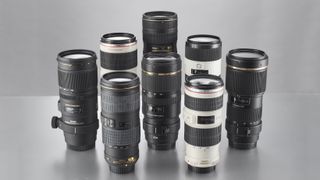The best 70-200mm lens is a true workhorse lens. Beloved by pro photographers and enthusiasts alike, this telephoto zoom focal range is ideal for all sorts of different shooting environments. Whether you're going for sports, wildlife, news, events, portraits or whatever else, a 70-200mm lens is one of the best ways to make sure you can get the shot.
The most popular and well-known configuration of a 70-200mm lens is a 70-200mm f/2.8. These are the best choice, with their fast, constant f/2.8 aperture that gives you plenty of latitude to work in low light and also allows for the creation of shallow depth of field.
However, these lenses are designed for pros, and as such they tend to come with hefty pro-level price tags. If you're looking for something a little more budget-friendly, 70-200mm f/4 lenses can also be a good choice. They have the advantage of being lighter to carry, so can be a great choice for keeping your kit relatively lightweight and mobile. Some 70-200mm f/2.8 lenses, as we'll see, are seriously hefty bits of kit!
As 70-200mm lenses are designed for advanced users, they're always built with full-frame cameras in mind. However, this doesn't mean that APS-C owners can't make use of them; a Canon, Nikon or Sony full-frame lens will fit on an APS-C cameras, it'll just bump up the focal length. On APS-C, a 70-200mm lens will provide an effective focal length of 105-300mm (112-320mm for Canon DSLRs), giving you even more telephoto reach.
For this guide, we've included lenses for Canon, Nikon, Sony, Pentax and Panasonic L-mount. We've got optics from Canon and Nikon's newer mirrorless systems as well as their classic DSLRs, so whichever you use, there will be multiple lenses for you. All these manufacturers keep these systems regularly updated, but a good 70-200mm lens tends to have a long shelf life, so there's a mix of new and old lenses in here.
Note: Sigma is due to launch its first mirrorless 70-200mm in December 2023. The Sigma 70-200mm f/2.8 DG DN OS Sports will be available in both Sony mount and L-mount
The best 70-200mm lenses in 2023
Why you can trust Digital Camera World Our expert reviewers spend hours testing and comparing products and services so you can choose the best for you. Find out how we test.
Canon EF mount
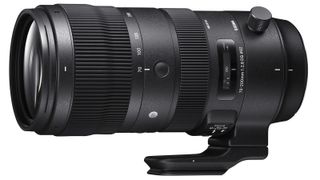
This new 70-200mm lens from Sigma has been redesigned from the ground up. The new optical path features 24 elements in 22 groups, incorporating nine FLD elements and one SLD element. There’s also a well-rounded aperture, based on 11 diaphragm blades. The autofocus system can be switched to Auto-Priority or Manual-Priority modes, the latter enabling manual override even in AI Servo autofocus mode. The design also features three AF-stop buttons, with the option of use as AF-on buttons via custom functions menus in enthusiast/pro grade cameras. The new optical stabilizer has switchable static and panning modes, the latter working in landscape, portrait and even diagonally. Optical performance is outstanding, with sharpness and contrast being fabulous across the entire zoom range, even when shooting at f/2.8. Autofocus is rapid and consistently accurate, and while stabilization isn’t quite as effective as in Tamron's rival SP 70-200mm f/2.8 Di VC USD G2 lens for static shots, it proved better for panning during our tests.
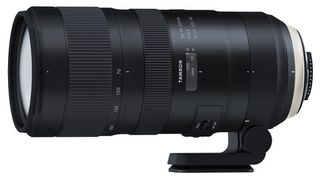
The Tamron G2’s optical design has been refined to increase sharpness and contrast, while reducing colour fringing, ghosting and flare. The autofocus system is uprated for faster, more accurate performance, and the VC (Vibration Compensation) system has three switchable modes and up to 5-stop effectiveness. Along with a full set of weather-seals, the lens has a fluorine coating on the front element. The lens is noticeably smaller and about 300g lighter than the Sigma, and has a more typical 77mm filter thread. As claimed, autofocus is very fast and operates with excellent precision. Image quality is absolutely on a par with Canon's EF 70-200mm f/2.8L IS III USM, with similarly impressive sharpness and contrast at all zoom and aperture settings, along with minimal distortions and colour fringing. But bear in mind that this Tamron is considerably less expensive than the latest Canon 70-200mm f/2.8, and the choice is clear.
Read more: Tamron SP 70-200mm f/2.8 Di VC USD G2 review
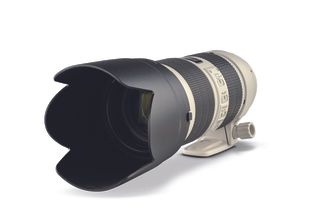
At a glance, you’d be hard pressed to spot any difference in Canon’s latest Mark III edition of its 70-200mm f/2.8 lens from its Mark II predecessor. It’s a slightly paler shade of grey and the front and rear elements gain a fluorine coating to repel grease and moisture, and to make cleaning easier. Internally, Canon’s high-tech ASC (Air Sphere Coatings) has been added to one of the elements to reduce ghosting and flare. However, the actual optical path, autofocus system and Image Stabilizer remain the same. It’s interesting to note that the stabilizer is now rated at 3.5-stops rather than the previous lens’s 4-stops, but that’s probably down to Canon switching to CIPA-based ratings. This Mark III lens is as exciting as its predecessor for sharpness and contrast across the zoom range. Autofocus is super-fast and there’s even better resistance to ghosting and fl are, living up to Canon’s claims. The bottom line is the new lens doesn’t outperform rival Sigma and Tamron lenses, yet it does cost noticeably more, making it poor value for money.

This lens costs more than some 70-200mm f/2.8 lenses from Sigma and Tamron, despite being one f/stop slower. The upside, as usual, is that the f/4 aperture rating enables smaller-diameter elements, and, therefore a smaller and lighter build overall. This lens has seen some sweeping changes compared with its predecessor. These include a revised optical design for better overall image quality and a closer minimum focus distance. Coatings are upgraded to further reduce ghosting and flare, and keep-clean fluorine coatings are added to the front and rear elements, although top-tech Air Sphere Coatings are not employed. The revamped image stabilizer is particularly impressive, with a 5-stop CIPA rating. Unlike the EF 70-200mm f/2.8L IS III USM lens, this one also gains a third IS mode, in which stabilization is only applied during exposures. All in all, it the f/4 II lens feels much more of an upgrade than the more expensive f/2.8 III option.
Canon RF mount
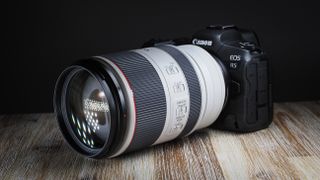
Think 70-200mm f/2.8 and you’re probably thinking of a fairly large lens that has a fixed physical length when zooming in and out. Canon’s new telephoto zoom for R-series cameras bucks the trend by featuring an inner barrel that extends as you sweep from short to long focal lengths, more like a typical 70-300mm optic. The bonus is that it’s considerably smaller for stowing away, and refreshingly lightweight for this class of lens, at just over a kilogram. There’s certainly nothing lightweight about the price tag, although the build quality and feature set are up to Canon’s usual high standards for L-series lenses. As such, it features a tough, weather-sealed construction, amazingly rapid yet virtually silent Dual Nano USM autofocus, a customizable control ring and 5-stop triple-mode image stabilization. Overall performance and image quality are fabulous.

Canon's RF 70-200mm f/4L IS USM is easily the shortest and lightest 70-200mm f/4 in the world. Side-by-side it's only slightly larger than a soda can when the lens is fully collapsed, while it's shorter and lighter than the f/2.8 variant above. It doesn't compromise on performance though, delivering an impressive 7.5 stops of stabilization (on an EOS R6 or R5 at least), making it incredibly versatile for a range of shooting situations. Optically and center sharpness is fantastic as well, even at 200mm, though corner sharpness can be a little disappointing. Somewhat frustratingly though the lens is not compatible with teleconverters, while it's very pricey compared to the EF version, which admittedly isn't quite as advanced. Though issues aside, this is a cracking lens for R-series shooters.
Nikon F mount

Top-flight Nikon professional photographers are still likely to stay loyal to own-brand Nikon glass and choose an AF-S 70-200mm f/2.8E FL ED VR, but this Sigma Sports alternative matches the Nikon in almost every aspect of handling, performance and image quality. That’s no mean feat considering that the Sigma is a little over half the price. Its optical path features 24 elements in 22 groups, incorporating nine FLD elements and one SLD element. There’s also a well-rounded aperture, based on 11 diaphragm blades. The new optical stabilizer has switchable static and panning modes, the latter working in landscape, portrait and even diagonally. As we’ve seen in a number of other Sigma lenses, dual ‘Custom’ modes can be switched on. Sharpness and contrast are fabulous throughout the entire zoom range, even when shooting wide open at f/2.8. Autofocus is rapid and accurate, and while it’s bigger and heavier than competing lenses, it goes extra-large on performance – a brilliant buy for Nikon FX DSLRs.
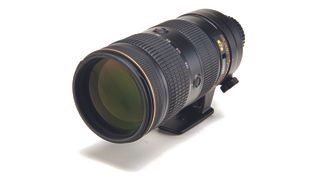
The latest and greatest edition of Nikon’s 70-200mm f/2.8 lens has a completely revamped optical design, including a fluorite element, six ED (Extra-low Dispersion) elements, one HRI (High Refractive Index) element and nano-structure coatings. The optics are wrapped up in a tough yet reasonably lightweight, weather-sealed magnesium alloy barrel. The upgraded VR (Vibration Reduction) system is worth four stops and gains a switchable ‘Sport’ mode for tracking erratically moving subjects in the viewfinder. Sharpness and contrast are legendary, throughout the zoom range. However, the cheaper Sigma 70-200mm f/2.8 Sports lens goes toe to toe with the Nikon for sharpness in real-world shooting, while matching other aspects of the Nikon’s image quality, autofocus speed and the stabilization effectiveness.

This Tamron 70-200mm f/2.8 G2 is a great-value lens. It's a little more compact and is about 300g lighter than Sigma's rival 70-200mm f/2.8 DG OS HSM | S lens, plus you get the added bonus of a completely removable tripod mount ring with an Arca-Swiss compatible foot. The G2’s optical design has been refined to increase sharpness and contrast, while reducing colour fringing, ghosting and flare. The autofocus system is uprated for faster, more accurate performance, and the VC (Vibration Compensation) system has three switchable modes and up to 5-stop effectiveness. All weather versatility is ensured by a full set of weather-seals, along with a fluorine coating on the front element to bead away water droplets. The autofocus is very fast and operates with superb precision. Overall handling and performance is excellent, especially considering this is only half the price of the Nikon lens.

Announced at the end of 2012, this telephoto zoom lens filled a longstanding void in Nikon’s lens line-up, in the shape of a relatively compact and lightweight 70-200mm lens. However, Nikon has now sadly discontinued this lens, and stock of new examples is drying up. Even so, we reckon it's still worth hunting down as a used buy.
Weighing in at a reasonable 850g, this lens is light enough to use on a tripod or monopod without a mount ring, but an optional ring is available, albeit at a price. Although this lens has a weather-sealed mount, it lacks the full weather-seals or magnesium barrel of Nikon’s f/2.8 lens. Despite having a mostly plastic construction it still feels robust and well-engineered. Helped by three ED (Extra-low Dispersion) elements and an HRI (High Refractive Index) element, sharpness and contrast are superb, while colour fringing is negligible. Nano-structure coatings keep ghosting and flare to a minimum and the 4-stop stabilizer is also highly effective.
Nikon Z mount
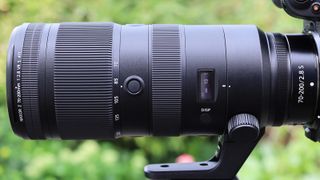
Unlike Canon’s competing 70-200mm f/2.8 lens for its EOS R series cameras, Nikon’s fast telephoto zoom for Z-mount mirrorless bodies has a fixed physical length, rather than shrinking at smaller focal lengths. It’s therefore more conventional for this class of lens. There’s less risk of dust being sucked in during the zooming process but the lens is considerably bigger and heavier, with similar dimensions and weight to most DSLR-format lenses. The, handling is excellent, benefitting from dual customisable L-Fn (Lens Function) buttons, a customisable control ring, 5-stop optical stabilization, an autofocus range limiter switch and a multi-function display panel. It’s very pricey for a 70-200mm f/2.8 zoom but the performance and image quality make it worth the money.
Sony E mount
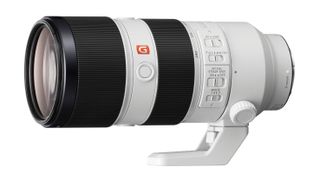
The sheer bulk of this lens makes it look a bit of a mismatch on A7 and A9-series bodies. However, handling is very refined nonetheless. Focus hold buttons encircle the forward section of the lens and the lens includes OSS (Optical SteadyShot) stabilization. Sony doesn’t give an official rating for its effectiveness, but we found that, when used in conjunction with stabilization in recent A7 series cameras, the combined stabilisation effect is worth up to five stops. The high-tech autofocus system incorporates ultrasonic ring-type drive for the larger moving elements, plus dual linear motors for the smaller ones. Weather-sealed build is of a fully professional-grade standard and image quality is similarly impressive. Sharpness and contrast are outstanding, and the extremely well-rounded 11-blade diaphragm helps the lens to retain delicious bokeh when the aperture is stopped down a bit.
Update: Sony has gone some way towards addressing the main issue with its first-generation 70-200mm f/2.8 lens in the form of its successor: the FE 70-200 f/2.8 GM II. This updated version is a full 29% lighter, and also boasts new video features and faster autofocus. It's currently hit by the same supply issues plaguing a lot of the imaging industries, but hopefully we'll see samples hitting shelves soon. When that day comes, we suspect it'll earn a place in this guide.
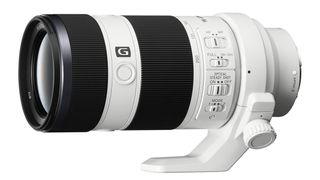
The Sony FE 70-200mm f/4 G OSS is a great lens that’s smaller and much lighter than Sony's FE 70-200mm f/2.8 G Master OSS lens, and only costs around half the price. It's true that a 70-200mm f/2.8 is seen as a 'must have' lens in any professional system, but you pay the price very literally, and there's a weight penalty with the f/2.8 version, too. This f/4 lens is cheaper, lighter, a lot less expensive, yet only one f-stop slower. See our full Sony FE 70-200mm f/4 G OSS review.
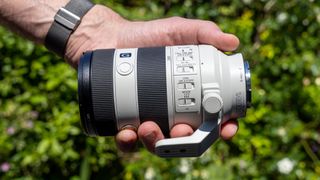
The newer 2023 edition of the Sony 70-200mm sets out to take everything up a notch or two from is older (and less expensive) predecessor. It is lighter and has can focus much closer - in fact, can deliver 0.5x magnification close-ups.
Another upgrade in the Mark II is a new autofocus system. There was nothing wrong with that of the original, which was based on dual linear stepping motors. This time around, there’s a floating focus system that separates the focusing elements into two groups. Sony claims that autofocus is more precise and 20 percent faster than in the original lens, along with a reduction in focus breathing and virtually silent operation, catering to videographers.
The optical stabilizer represents another improvement, with an additional mode for tracking erratically moving subjects as well as the usual static and panning modes featured in the original lens.
Most importantly, for those who can afford the latest version, we found that in our lab tests that optical performance has been noticably improved.
Read our full Sony FE 70-200mm F4 Macro G OSS II review
Panasonic L-mount
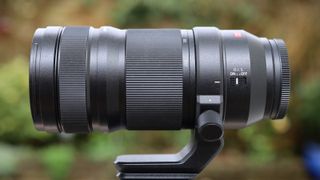
This telephoto zoom weighs in at just under a kilogram and makes for well-balanced shooting with Panasonic S-series cameras. The combination is also perfectly balanced on a monopod or tripod, if you use the removable tripod mounting ring that’s supplied with the lens. The high-tech optical path delivers sumptuous image quality and the constant f/4 aperture rating enables a fairly tight depth of field, while the quality of bokeh is nice and smooth. Autofocus is super-fast and the built-in optical image stabilizer works in conjunction with the 5-axis, sensor-shift stabilizers of S-series bodies to give an effectiveness of up to 6-stops. It’s quite pricey for a 70-200mm f/4 zoom but you definitely get what you pay for, and it’s only about two-thirds the weight of Panasonic’s pricier 70-200mm f/2.8 zoom.
Read more: Panasonic Lumix S PRO 70-200mm f/4 OIS review

Panasonic’s range-topping 70-200mm zoom is about 50 per cent heavier and 50 per cent pricier than it’s excellent f/4 stablemate. As well as being an f/stop faster, the f/2.8 lens gains switchable static and panning optical stabilization modes and a set of three customisable function buttons, typically used for AF-hold. As usual for Panasonic PRO lenses, this one is Leica certified and has a tough splash/dust-proof construction. It comes complete with a removable tripod mounting collar, which has an Arca-Swiss compatible foot. Autofocus is rapid and virtually silent, and the absence of focus breathing is a bonus for video capture. Image quality is very good overall, with smooth bokeh and entirely negligible distortions or colour fringing. In our tests, however, the lens didn’t prove quite as sharp as the less expensive f/4 zoom.
Read more: Panasonic Lumix S PRO 70-200mm f/2.8 O.I.S. review
Pentax K-mount

This high-end 70-200mm f/2.8 zoom (a classic combination for pro photographers) has a star designation (*) in its name, which is usually only given to Pentax's pin-sharp, top-shelf prime lenses. Does it earn it? According to our lab results, yes (just about) – we gave the lens a thorough resolution test, and found it to deliver excellent centre sharpness throughout the zoom range. The autofocus system is swift and quiet, making use of a DC motor, and having Pentax’s ‘Quick-Shift Focus System’ is handy for moments when you want to quickly override the autofocus with manual operation.
All this sophistication does make the HD Pentax-D FA* 70-200mm f/2.8 ED DC AW a relatively expensive lens. If you're working to a budget, Pentax's cheaper HD Pentax-D FA 70-210mm F4 ED SDM WR could prove an excellent alternative.
Read more:
Best 150-600mm lenses
Best 100-400mm lenses
